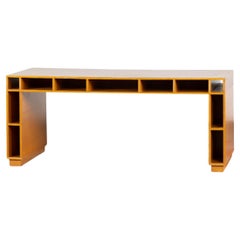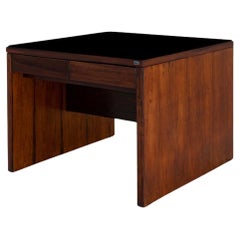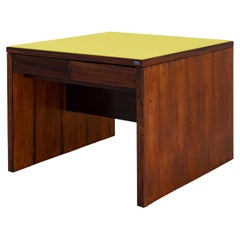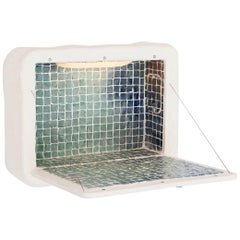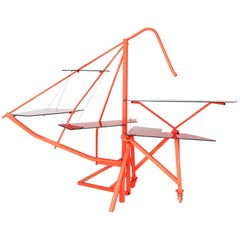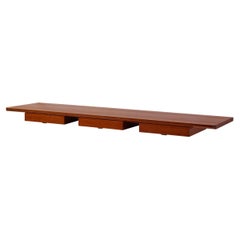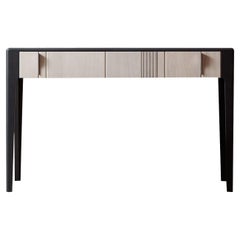Side-Gallery Desks and Writing Tables
to
Height
to
Width
to
Depth
to
7
1
5
3
1
5
3
4
1
3
1
6
3
3
2
2
5
3
3
3
1
8
8
8
3
1
1
1
Ricardo Bofill 1990 Desk
Located in Barcelona, ES
Anabelle d'Huart & Ricardo Bofill Desk
France, 1993
Manufactured by Ricardp Bofill
Veneer
180 x 80 x 76h cm
70,9 x 31,5 x 29,9h in
Private Collection
Category
1990s French Desks and Writing Tables
Materials
Wood
$27,697
Office Desk model “Square” by Joaquim Tenreiro, 1966
By Joaquim Tenreiro
Located in Barcelona, ES
Office Desk model "Square"
Manufactured by Tenreiro Moveis e Decoraçao
Brazil, 1966
Jacaranda, Glass
Measurements
100 cm x 100 cm x 76h cm
39,3 in x 39,3 in x 29,9h in
Provenance
T...
Category
Vintage 1960s Brazilian Desks and Writing Tables
Materials
Glass, Jacaranda
Desk by Joaquim Tenreiro, 1966
By Joaquim Tenreiro
Located in Barcelona, ES
Desk
Created for the offices of Bloch Editores, Sao PAulo
Brazil, 1966
Jacaranda (rosewood) wood
Measurements
145 cm x 70 cm x 75h cm
57 in x 27,55 in x 29,52h in
Details
Paqule of...
Category
Vintage 1960s Brazilian Desks and Writing Tables
Materials
Wood, Jacaranda, Rosewood
Office Desk model “Square” by Joaquim Tenreiro, 1966
By Joaquim Tenreiro
Located in Barcelona, ES
Office Desk model "Square"
Manufactured by Tenreiro Moveis e Decoraçao
Brazil, 1966
Jacaranda, Glass
Measurements
100 cm x 100 cm x 76h cm
39,3 in x 39,3 in x 29,9h in
Detail
This ...
Category
Vintage 1960s Brazilian Desks and Writing Tables
Materials
Glass, Jacaranda
Côme Clérino Contemporary Ceramic Tiled Wall Desk Model "Le Solitaire Blue" 2021
By Côme Clérino
Located in Barcelona, ES
Wall desk model "Le Solitaire Blue"
Manufactured by Côme Clérino
Produced in exclusive for Side Gallery
Paris (France), 2021
Polystyrene, stainless, steel, plaster, oakum, ceramic, enamel, tile joint, electronic components, polyester resin, fiberglass, wood and PU foam.
Measurements
76 cm x 69 cm x 58h cm (18 cm depth desk shut)
29,92 in x 27,16 in x 22,83h in (7 in depth desk shut)
Edition
Unique Piece
Côme Clérino (1990, Paris) lives in Paris and works in Pantin, France. After graduating from the École Nationale Supérieure des Beaux-Arts de Paris in 2016, he developed a multidisciplinary practice shaking up the academic definition of painting and integrating photography, drawing, sculpture, ceramics, textiles and installation. In 2017, he presented his first solo exhibition, Voir au verso, at Les Gens Heureux gallery in Copenhagen. In 2018, after a new solo exhibition, Emulsilfy(ing), at the Castellana 22 gallery in Madrid, he was nominated for the International Painting Prize of Vitry-sur-Seine.
In 2019, he presented his first solo show in France, Et si on passait les meubles par la fenêtre?, at the Double V Gallery...
Category
21st Century and Contemporary French Shelves and Wall Cabinets
Materials
Ceramic, Resin, Fiberglass, Foam, Plaster, Wood
Contemporary Orange Desk/Book Shelf by Guillermo Santomá Contemporary Design
By Guillermo Santomà
Located in Barcelona, ES
Desk or bookshelf
Manufactured by Guillermo Santomá
Edition Side Gallery
Barcelona, 2018
Aluminium, spray painting, wheels, methacrylate.
Category
2010s Spanish Desks and Writing Tables
Materials
Aluminum
Franco Albini Mahogany mid-centry Italian Table Model TL-22 produced by Poggi
By Franco Albini
Located in Barcelona, ES
Franco Albini & Franca Helg.
Dining table model no. TL22.
Manufactured by Poggi,
Italy, 1958.
Mahogany.
Measurements:
180.3 cm x 104.1 cm x 73 H cm.
70.98 in x 40.98 in x 28.74 in.
Literature:
Giuliana Gramigna, Repertorio 1950/1980, Milan, 1985, p. 123.
Franco Albini, was born in 1905 and died in 1977. He spent his childhood and part of his youth in Robbiate in Brianza, where he was born. Albini, as an adolescent moved with his family to Milan. Here he enrolled in the Faculty of Architecture of the Polytechnic and graduated in 1929. He started his professional activity in the studio of Gio Ponti and Emilio Lancia, with whom he collaborated for three years. At the 1929 International Exhibition in Barcelona (where Gio Ponti curated the Italian pavilion and Mies van der Rohe realized that of Germany) and in Paris where, as Franca Helg recounted, he had the opportunity to visit the studio by Le Corbusier.
In those three years, the works he carried out are admittedly of the twentieth century imprint. It is the meeting with Edoardo Persico that marked a clear turning point towards rationalism and the approach to the group of editors of "Casabella". The partly ironic and partly very harsh comments of the Neapolitan critic to a series of drawings, made by Albini for the design of some office furniture, caused him a great disturbance. “I spent days of real anguish - Albini recalls - I had to answer all the questions. I also had a fever, a large and long fever. "
The meted provoked Albini to openen a professional studio in via Panizza with Renato Camus and Giancarlo Palanti. The group of architects began to deal with public housing by participating in the competition for the Baracca district in San Siro in 1932 and then building the IFACP neighborhoods: Fabio Filzi (1936/38), Gabriele D'Annunzio and Ettore Ponti (1939).
During this period, Albini also worked on his first villa (Pestarini), which Giuseppe Pagano, architect and critic of the time, presented as follows: “This coherence, which the superficial rhetoric of fashionable jugglers calls intransigence, and which is instead the basis of understood between the fantasy of art and the reality of the craft, in Franco Albini, it is so rooted that it transforms theory into a moral attitude ".
But it is above all in the context of the exhibitions that the Milanese master experienced his compromise between that "rigor and poetic fantasy" of which Pagano speaks, coining the elements that became a recurring theme in his . The opening in 1933 of the new Triennale headquarters in Milan, in the Palazzo dell'Arte, was an important opportunity to express the strong innovative character of rationalist thinking, a gym in which to freely experiment with new materials and new solutions, but above all a "method". "Cultivated as a communication laboratory, the art of setting up was for the rationalists of the first generation what the perspective had been for the architects of humanism: the field open to a hypothesis of space that needed profound reflections before landing the concreteness of the construction site ".
Together with Giancarlo Palanti, Albini on the occasion of the V Triennale di Milano set up the steel structure house (with R. Camus, G. Mazzoleni, G. Minoletti and with the coordination of G. Pagano), for which he also designed the 'furniture. At the following Triennale of 1936, Persico dided, together with a group of young designers gathered by Pagano in the previous edition of 1933, Franco Albini took care of the preparations of the home exhibition. The setting up of Stanza per un uomo, at that same Triennale, allows us to understand the acute and ironic approach of Albini, as a man and as a designer: "Celebrating the beauty of mechanics was the imperative to which, for example, the surprising displays by Franco Albini who managed, in the subtle way of a refined and rarefied style, to sublimate their practical content in the metaphysics of daring still lifes: flying objects which marked in the void refined frames and metal intricacies the nodes of a fantastic cartography where industry finally became art free from purpose ".
That same year Albini and Romano designed the exhibition of the Ancient Italian Goldsmithery: vertical uprights, simple linear rods, designed the space. A theme, of the "flagpole", seemed to be the center of the evolution of production and the creative process. The concept is reworked over time, with the technique of decomposition and recomposition typical of Albinian design: in the preparation of the Scipione Exhibition and contemporary drawings (1941) the tapered flagpoles, on which the paintings and display cases were hung, are supported by a grid of steel cables; in the Vanzetti stand (1942) they take the V-shape; in the Olivetti shop in Paris (1956) the polished mahogany uprights support the shelves for the display of typewriters and calculators.
The flagpole is found, however, also in other areas. In the apartments he designed, it is used as a pivot on which the paintings can be suspended and rotated to allow different points of view, but at the same time as an element capable of dividing the spaces. The Veliero bookcase...
Category
Mid-20th Century Italian Mid-Century Modern Dining Room Tables
Materials
Mahogany
Lukas Saint-Joigny, Contemporary Desk/Table, Blue, Polyurethane, Paris, 2020
By Lukas Saint-Joigy
Located in Barcelona, ES
Lukas Saint-Joigny
Desk
From the “Ore” series
Manufactured by Lukas Saint-Joigny
Produced in exclusive for SIDE GALLERY
Paris, 2020
Various materials and polyurethane
Measur...
Category
21st Century and Contemporary French Desks and Writing Tables
Materials
Resin
Related Items
Osvaldo Borsani wall-mounted wood and brass desk model E22 by Tecno Italy, 1950s
By Tecno, Osvaldo Borsani
Located in Chiavari, Liguria
A wall-mounted desk in wood, metal, and brass, part of the E22 series, produced by Tecno, designed by Osvaldo Borsani, 1950s
A wall-mounted piece of furniture, free from floor suppo...
Category
Vintage 1950s Italian Mid-Century Modern Desks and Writing Tables
Materials
Metal, Brass
$6,128
H 9.06 in W 82.68 in D 21.66 in
Domino Wall Writing Desk
By Modesign
Located in Milan, IT
Wall writing desk with 1 drawer and ribbed slat. It is curated with anthracite and plaster finish and two gunmetal handles.
Category
2010s Italian Desks and Writing Tables
Materials
Wood
Wall-Mounted Writing Desk or Catch All
By Lost City Arts
Located in New York, NY
Highly functional and stylish piece. Perfect solution to the modern clutter dilemma, the desk features three color coded letter dividers to the right with a single storage slot to th...
Category
20th Century American Modern Desks and Writing Tables
Materials
Laminate, Walnut
Elinor McGuire Model 226c Writing Desk
By John and Elinor McGuire, McGuire
Located in Highland, IN
This exquisite design by Elinor McGuire for McGuire of San Fransisco is an exercise in subtle beauty and refined detailing. With a body covered in cane, slightly splayed legs, and so...
Category
Vintage 1970s American Modern Desks and Writing Tables
Materials
Brass
vintage desk desk 60s J. Svenstrup Danish
By Svenstrup Ap Mobler
Located in Lemmer, NL
vintage desk desk 60s J. Svenstrup Danish
period 60's
design J. Svenstrup AP Denmark Denmark
condition good light signs of use missing rear hand...
Category
Vintage 1960s Danish Desks and Writing Tables
Materials
Teak
"Zeno" Asymmetrical Beech and Ebony Desk by Massimo Scolari for Giorgetti, 1990s
By Giorgetti S.p.A., Massimo Scolari
Located in Los Angeles, CA
A well crafted asymmetric 90's desk designed by Massimo Scolari for Giorgetti S.p.A. The desk is made of a beech frame with Macassar Ebony inset top and aluminum hardware. The leg ha...
Category
1990s Italian Post-Modern Desks and Writing Tables
Materials
Aluminum
$2,950
H 28.75 in W 69.5 in D 31.5 in
Gallotti & Radice, President model desk, Italy, 1970s.
By Gallotti & Radice
Located in Palermo, PA
President desk model by Gallotti & Radice, Italian production from 1971.
Iconic, charming and essential design, perfect for a modern setting.
Transparent tempered glass and chrome-pl...
Category
Vintage 1970s Italian Mid-Century Modern Desks and Writing Tables
Materials
Crystal, Metal
$883 Sale Price
50% Off
H 28.94 in W 46.07 in D 23.63 in
Brazilian Modern Desk in Hardwood by Joaquim Tenreiro for Bloch, 1966, Brazil
By Joaquim Tenreiro
Located in New York, NY
Available today, this Midcentury Modern Desk in Brazilian Rosewood, known as Jacaranda designed by Joaquim Tenreiro for Bloch Editores in the 1966 is nothing less than spectacular.
...
Category
Vintage 1960s Brazilian Mid-Century Modern Desks
Materials
Hardwood
$22,000
H 29.53 in W 57.09 in D 27.56 in
Joaquim Tenreiro, Desk, Jacaranda, Brazil, 1960s
By Joaquim Tenreiro
Located in High Point, NC
A jacaranda desk designed by Joaquim Tenreiro, Brazil, 1960s.
Designed and produced for Bloch Editores S.A. Building, Rio De Janeiro, Brazil.
Category
Vintage 1960s Brazilian Mid-Century Modern Desks and Writing Tables
Materials
Jacaranda
Glass, Painted wood & Chrome Plated Metal 1990s desk by Gallotti e Radice
By Gallotti & Radice
Located in Varese, Lombardia
Minimal Desk with wheeled chest of drawers in white lacquered wood, thick cut glass and chrome plated metal.
Minimal and elegant Desk with chest of drawers on wheels in white lacqu...
Category
1990s Italian Modern Desks and Writing Tables
Materials
Metal, Chrome
$3,453
H 29.14 in W 55.04 in D 23.82 in
Simon Desk
Located in Carmel, CA
Designed by Ashley Yeates, 'The Modern Hepburn,' handcrafted in California using FSC-certified wood and non-toxic finishes. COM/COL
Maximize your home workspace with the Simon desk...
Category
2010s Desks and Writing Tables
Materials
Wood
Briccola-ge Corner Desk and Shelf in solid Oak Wood and black lacquered brackets
By Miki Astori
Located in Milan, Lombardy
“The corner is a piece of home mistreated. A dead end with no way out. In every reality, in every culture, the corner is never dutifully considered”…. So, between the serious and the facetious, Miki Astori explains the project of Briccola-ge, a two- story practical and poetic work plan or small console where to operate in transitory moments.
The wall hanging supports are in a mass-colored wooden technical material.
The tops are made of solid oak strips with inserts of Briccola Veneziana, the old wooden dolphins...
Category
21st Century and Contemporary Italian Minimalist Shelves and Wall Cabinets
Materials
Oak, Bog Wood
$1,580
H 9.85 in W 39.38 in D 18.51 in
